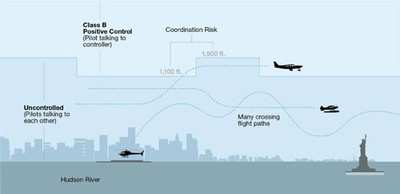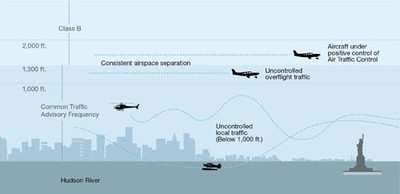Chief Operation Officer Henry Krakowski Outlines New Procedures
For Congressional Panel
 FAA Air Traffic Organization Chief
Operation Officer Henry Krakowski told the House Committee on
Transportation and Infrastructure, Subcommittee on Aviation, that
the FAA has already implemented some changes in the Hudson River
corridor following last months' fatal mid-air collision, and that
the process for rulemakeing is being expedited.
FAA Air Traffic Organization Chief
Operation Officer Henry Krakowski told the House Committee on
Transportation and Infrastructure, Subcommittee on Aviation, that
the FAA has already implemented some changes in the Hudson River
corridor following last months' fatal mid-air collision, and that
the process for rulemakeing is being expedited.
"Since the investigation of the accident remains under the
formal processes of the National Transportation Safety Board
(NTSB), I will not be commenting on the specifics of the accident,"
he said in prepared remarks. "I will, however, share with you the
immediate actions we have taken, as well as discuss some of our
longer-range plans to improve safety."
Krakowski outlined the "VFR Flyways" in which pilots have been
allowed to operate under "see and be seen" rules in the corridor.
"(T)his VFR flyway is commonly called the “exclusion
area,” which has existed in some form since 1971, and is
bounded by the Hudson River and has a ceiling of either 1,100 feet
or 1,500 feet.

Chart Showing Current Airspace
Use
The August 11 NOTAM reiterated long-recommended practices for
this VFR flyway, including speed limitations (not exceeding 140
knots) and taking precautionary measures (turning on
anti-collision, position/navigation, and/or landing lights and
self-announcing their position on the Hudson River frequency for
all other aircraft to hear)."
He also described the efforts of the task force created to study
how air traffic uses the Husdon River corridor, and outlined the
recommendations of that group. " One of the most significant
changes would divide the airspace into altitude corridors that
separate aircraft flying over the river from those operating to and
from local heliports or seaplane bases."
Krakowski said the new exclusionary zone would be comprised of
four components:
- It would establish a uniform “floor” for the Class
B airspace over the Hudson River at 1,300 feet, which would also
serve as the “ceiling” for the exclusionary zone. This
removes some confusing complexity that currently exists.
- Between 1,300-2,000 feet, aircraft will operate in the Class B
airspace under visual flight rules but under positive air traffic
control and communicate with controllers on the appropriate air
traffic frequency.
- Below 1,300 feet, aircraft must use a single common radio
frequency. Mandatory routes for aircraft flying up and down the
river will require them to favor the “right side” of
the river (i.e. the east side for northbound traffic and the west
side for southbound traffic) to provide horizontal separation as
well.
- Coordination of traffic and handoffs between Air Traffic
Controllers at the Teterboro tower, Newark tower, and radar control
will be improved."

Chart Showing Proposed Airspace
Use
Krakowski concluded that the proposed changes for the Hudson
Corridor could have implications for the broader air traffic
control system nationwide. "As we implement these changes in the
New York airspace and have an opportunity to analyze their
effectiveness, the FAA intends to examine the other major
metropolitan areas and congested corridors for similar airspace and
operational risks to see if such procedures would be appropriate
elsewhere. We expect this larger effort to carry well into next
year," he said.
 ANN's Daily Aero-Term (04.28.24): Airport Marking Aids
ANN's Daily Aero-Term (04.28.24): Airport Marking Aids Aero-News: Quote of the Day (04.28.24)
Aero-News: Quote of the Day (04.28.24) ANN's Daily Aero-Linx (04.28.24)
ANN's Daily Aero-Linx (04.28.24) Aero-News: Quote of the Day (04.29.24)
Aero-News: Quote of the Day (04.29.24) ANN's Daily Aero-Linx (04.29.24)
ANN's Daily Aero-Linx (04.29.24)





